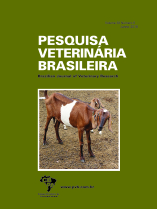 |
|
|
|
Year 2018 - Volume 38, Number 6
|

|
Occorrence and risk factors associated with small ruminant lentivirus infection in the State of Sergipe, Brazil, 38(6):1043-1050
|
ABSTRACT.- Rizzo H., Jesus T.K.S., Castro R.S., Pinheiro Júnior J.W., Soares L.L.S., Oliveira C.C.M., Nascimento S.A. & Silva T.R. 2018. [Occorrence and risk factors associated with small ruminant lentivirus infection in the State of Sergipe, Brazil.] Ocorrência e fatores de risco associados à infecção por lentivírus de pequenos ruminantes no Estado de Sergipe. Pesquisa Veterinária Brasileira 38(6):1043-1050. Departamento de Medicina Veterinária, Universidade Federal Rural de Pernambuco, Rua Dom Manoel de Medeiros s/n, Dois Irmãos, Recife, PE 52171-900, Brazil. E-mail: hubervet@gmail.com
The lentiviruses of small ruminants are infectious and multisystemic diseases caused by the Caprine Arthritis Encephalitis Virus (CAEV) and the Maedi-Visna Virus (MVV), and present the clinical forms: articular, mammary, respiratory and nervous. This work aimed to determine the occurrence and to evaluate the risk factors associated with lentivirus infection of small ruminants in the State of Sergipe, Brazil. Blood samples were collected from 1200 sheep and 675 goats from 60 and 41 farms respectively, located in 25 Sergipe municipalities from 2011 to 2014. The diagnosis of small ruminant lentiviruses (LVPR) was determined by the serological technique of Immunodiffusion in Gel Agar (IDGA) using the commercial kit of the brand Biovetech. Data from the variables associated with risk factors were obtained from questionnaires applied to the owners of the herds and analyzed statistically. Absolute and relative frequencies were determined by descriptive statistical analysis and risk factors by univariate analysis of the variables of interest by Pearson’s Chi-square test and Fisher’s exact test, when necessary. A logistic regression analysis was used, considering as a dependent variable for LVPR infection the reactive or non-reactive result observed in the IDGA. A seropositivity of 5.03% (34/675) was observed in goats and 1.50% in sheep with 26.82% (11/41) and 28.33% (17/60) of the properties had at least one animal positive respectively. The analysis of the risk factors, no significant differences were observed for sheep, while for goats, herds above 100 animals grazing in common areas with other herds, at a distance ≤ 500 meters between the properties, that adopt Biotechnological measures of reproduction and do not use sterile needles, are more susceptible to LVPR infection. Therefore, it´s concluded there is presence of lentiviruses of small ruminants in sergipan herds, and even if at low frequencies it is necessary to implement prophylactic measures due to the possibility of expansion and development of goat breeding of the state and the high genetic standard of the Santa Inês breed. |
| |
|
|
| |
|
 |